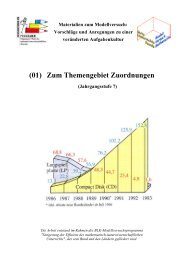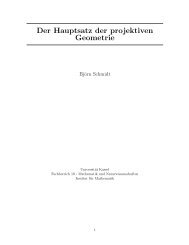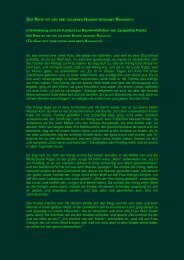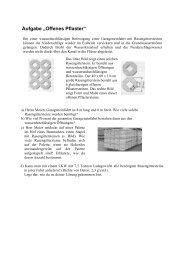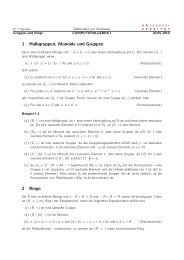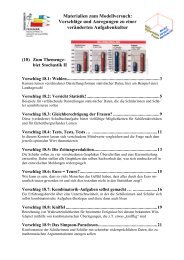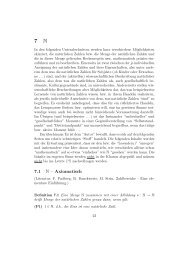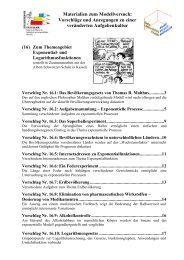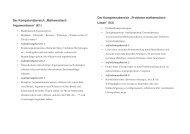Material zum Vorkurs P2 WiSe 2013/14
Material zum Vorkurs P2 WiSe 2013/14
Material zum Vorkurs P2 WiSe 2013/14
Sie wollen auch ein ePaper? Erhöhen Sie die Reichweite Ihrer Titel.
YUMPU macht aus Druck-PDFs automatisch weboptimierte ePaper, die Google liebt.
<strong>WiSe</strong> <strong>2013</strong>/<strong>14</strong><br />
30.09.<strong>2013</strong><br />
16. Tag – Differenzieren<br />
16. Tag – Differenzieren<br />
1 & 2. Übung: Differenzieren I & II – Aufgaben<br />
1.) Bilden Sie die erste, zweite und dritte Ableitung von:<br />
a) f(x) = x 4 b) f(x) = 2x 5 c) f(x) = 3x 4 + 4x 2<br />
d) f(x) = 3x 11 − 3x 7 e) f(x) = 3x −2 f) f(x) = 1<br />
x 3<br />
g) f(x) = 5x 4 + 2x −4 h) f(x) = 3x 8 − 2x 4 − 5 x + 2<br />
x 3<br />
2.) Bestimmen Sie<br />
a) f ′ (1) für f(x) = 3x 3 + 2x + 1 b) g ′ (π) für g(x) = 3x · sin(x)<br />
( ) 3<br />
c) h ′ (2) für h(x) = 2x 2 + x<br />
d) i ′ (0) für i(x) = x2 − 3x<br />
3x 3 − 2<br />
3.) Bestimmen Sie Definitionsbereich, Ableitung und Definitionsbereich der Ableitung für:<br />
a) f(x) = 1 4 x4 + 1 3 x3 + 1 2 x2 + x + 1 b) f(x) = x 2 + t 2 c) f(t) = x 2 + t 2<br />
( ) x 5<br />
d) f(x) =<br />
e) f(x) = cos 3x f) f(x) = cos x 3 g) f(x) = cos 3 x<br />
1 + x<br />
h) f(x) = (x 5 + sin x) 7 i) f(x) = √ x 2 − 5x + 6 j) f(x) = √ −x 4 + 11<br />
4.) Bilden Sie die erste und zweite Ableitung der folgenden Funktionen:<br />
a) f(x) = 3x 5 − 4x 3 + 1 2 x − 5 b) f(x) = sin x · cos x c) f(x) = x2 − 2x + 4<br />
x − 3<br />
d) f(x) = cos x · ln x e) f(x) = e 1 2 x2 f) f(x) = x 2 · arctan x<br />
g) f(x) = sin x<br />
x 3 h) f(x) = tan (e x )<br />
5.) Bestimmen Sie Definitionsbereich, Ableitung und Definitionsbereich der Ableitung für:<br />
a) f(x) = |x| b) f(x) = tan 1 x 2 c) f(x) = sin √ x d) f(x) = sin |x|<br />
e) f(x) = √ sin x f) f(x) = √ √ √<br />
x + 1<br />
|sin x| g) f(x) =<br />
h) f(x) = x + √ x + √ x<br />
x − 2<br />
6.) Berechnen Sie die erste Ableitung von<br />
a) f(x) = 5x 3 b) f(x) = 4x 4 + 1 2 x2 + 1 x<br />
c) f(x) = 3<br />
x 3 + 4x −1<br />
d) f(x) = − sin 2x e) f(x) = cos 2 x − tan x f) f(x) = arctan x + sin 1 x<br />
g) f(x) = e −x + e<br />
(<br />
x −2) h) f(x) = (e x ) 3 + arcsin x i) f(x) = ln x + ln 2<br />
3x<br />
f (x 0 + h) − f (x 0 )<br />
7.) Berechnen Sie den Grenzwert lim<br />
h → 0 h<br />
Gleichung der Tangente an den Graphen von f im Punkt<br />
für die Funktion f(x) = x 3 , x 0 ∈ R, und geben Sie die<br />
( )<br />
x 0 ,x0<br />
3 an.<br />
Mathematik <strong>Vorkurs</strong> <strong>P2</strong><br />
✞ ☎<br />
✝123 ✆<br />
Dipl. Math. Stefan Podworny





